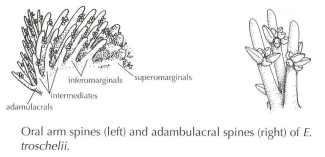Evasterias troschelii has a fairly distinctive colour, usually mottled green, red, brown or orange, with white spines and a lighter oral surface. It has five arms up to 30 cm long, and its arm-to-disc ratio ranges from 5.0 to 7.6. This is one of the most variable sea stars in this region (the area from Glacier Bay to Puget Sound to a depth to 200 metres), especially in the pattern of aboral spines, which varies from numerous small spines in a netlike pattern to longitudinal rows of large blunt spines on the arms. Fisher (1930) described three forms to cover this range of variability, but they are not geographically separated so are not considered subspecies. Papulae occur abundantly between the spines. A regular series of superomarginals curves upward at the junctions of the arms and meets the series from the adjoining arm. The first two rows of similar spines below the superomarginals are inferomarginals, the next four rows are oral intermediates. The adambulacrals alternately bear 1 and 2 spines. Three to five pairs of adambulacrals from adjoining arms fuse together to form an adoral carina. The mouth plates at the proximal end of the adoral carina bear two unequal marginal spines and one longer suboral spine. Lanceolate pedicellariae occur on the oral and adambulacral spines. Crossed pedicellariae occur on the aboral and marginal spines and also in clusters on the oral and adambulacral spines.
Characteristics
Similar SpeciesEvasterias troschelii is similar to Pisaster ochraceus, but it has a greater arm-to-disc ratio, more rows of spines between the marginals and ambulacral furrow, and a less sunken mouth. The six-armed star, Leptasterias hexactis,
